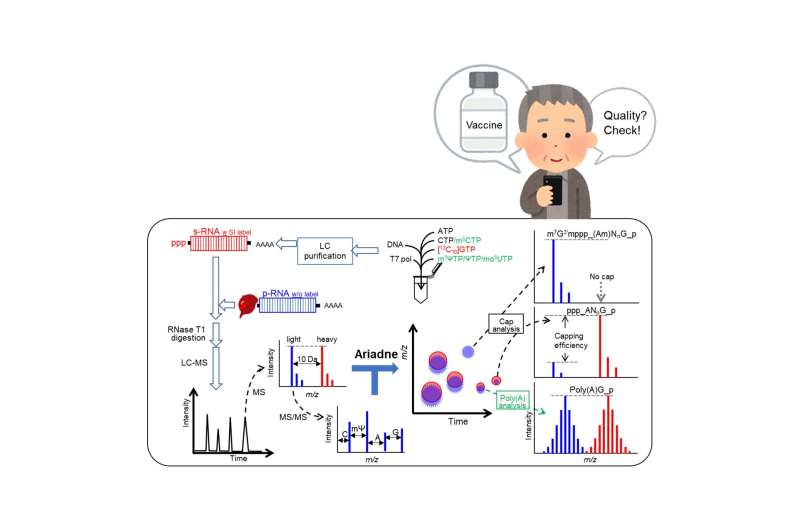This article has been reviewed according to Science X's editorial process and policies. Editors have highlighted the following attributes while ensuring the content's credibility:
fact-checked
peer-reviewed publication
proofread
New method for quantifying the structure of messenger RNA–based medications

Researchers from Tokyo Metropolitan University and RIKEN CSRS have developed a new analytical platform based on liquid chromatography, mass spectrometry and software analysis that quantifies the structure of messenger RNA–based medicines. They can elucidate mRNA sequences while quantifying "capping" at one end of the molecule and the integrity of the tail on the other, all vital in mRNA pharmaceuticals. The method is a crucial innovation for quality control in production lines.
Messenger RNA is a vital molecule responsible for transmitting the sequence information stored in our DNA to ribosomes, the protein-making machinery of our cells. However, the mRNA does not necessarily have to come from our DNA; by artificially designing mRNA molecules, we can use it as a drug which enables our cells to produce specific protein structures, like antigens which can trigger an immune response and act as a vaccine.
mRNA medicines burst into the public consciousness as the primary component of the most effective COVID-19 vaccines. They have many advantages over competing technologies: they are considered much safer, as they do not integrate into the host cell genome; they are relatively easy to manufacture and scale up. Now, the technology is said to hold promise for treating a wide range of other illnesses, including cancer and metabolic diseases.
But with the wide deployment of this new technology, methods are now needed to perform quality control in a more effective, efficient way. mRNA medicines have three key components: the sequence, which determines what proteins are synthesized; the 5'-capping, which ensures that the mRNA is read efficiently during protein translation; the poly(A) tail, which dampens the immune response against the foreign mRNA itself. All three need to be in good working order for the treatment to be effective. However, there is currently no method that can quantify the state of all three in one go.
Now, a team led by Drs. Masato Taoka of Tokyo Metropolitan University and Hiroshi Nakayama of RIKEN CSRS have developed an analytical platform combining liquid chromatography, mass spectrometry and automated software analysis to quantitatively monitor the properties of mRNA molecules. The result is published in the journal Analytical Chemistry.
The team's platform combines two important innovations. First, using liquid chromatography and mass spectrometry, they undertake a systematic comparison of different fragments of a mRNA molecule to be tested with a similarly fragmented reference mRNA labeled with a stable carbon isotope. Second, automated analysis using Ariadne software helps ascertain structures with the help of a sequence database.
The team found that their analysis platform could successfully assign the primary structure of the reference, then rapidly identify even the most minute changes in the mRNA molecule being tested, all while yielding quantitative information on the capping and tail group.
The method is applicable to a wide range of mRNA lengths and sequences from completely different origins, allowing all three parts to be analyzed in one go. It promises unparalleled efficiency in checking for the quality of mRNA medicines, both those in action now and yet to be developed.
More information: Hiroshi Nakayama et al, Liquid Chromatography–Mass Spectrometry-Based Qualitative Profiling of mRNA Therapeutic Reagents Using Stable Isotope-Labeled Standards Followed by the Automatic Quantitation Software Ariadne, Analytical Chemistry (2022). DOI: 10.1021/acs.analchem.2c04323
Journal information: Analytical Chemistry
Provided by Tokyo Metropolitan University




















